
I revisited Malta with a friend. Just for a week. A trip down memory lane for both of us. Revisiting a place where you had exciting experiences in the past is not something I would normally recommend. ‘Never go back’ is a phrase I have often heard because such experiences can seldom be repeated. However, circumstances change; countries change ‒ for better or worse. And there is always something different to do or see, sights you missed before. But more importantly perhaps, interests change as you progress through life’s stages. When I think of the tropical jungles I hacked through in my youth and never bothered to spot the birds or other wildlife therein, I feel regret. When I think of the huge and splendid churches, mosques and temples that I never visited, I feel more regret. Now in my mature years, I spend more time observing. I amble rather than stride. I appreciate more the history of a place, I get closer to the culture and people. So going back is not necessarily negative. And a dose of nostalgia is good for the soul. Rediscovering Malta, therefore, a small island stuffed full of history, was on the agenda.

Mdina
Mdina, where we chose to stay, crowns a hill in Central Malta. Not for us the noisy nightclubs of St Paul’s Bay with its mass of hotels. Mind you, it is November so not many tourists are braving the beach resorts. Even during this month though, we take breakfast some days outside on the hotel’s verandah, bordered by black painted railings and pink flowers in boxes. One morning I note that a group of Finnish guests are drinking prosecco for breakfast to accompany their fruit and croissants. Cheers. I gaze over the island from our hilltop retreat, the patchwork of fields dotted with trees and bushes, the dome of Mosta in the near distance, and the urban area of Valletta and the sea beyond. I watch a farmer doing things with a drystone wall and a black redstart hopping about on the stones. The bastions of the citadel gleam bright white in the sun.
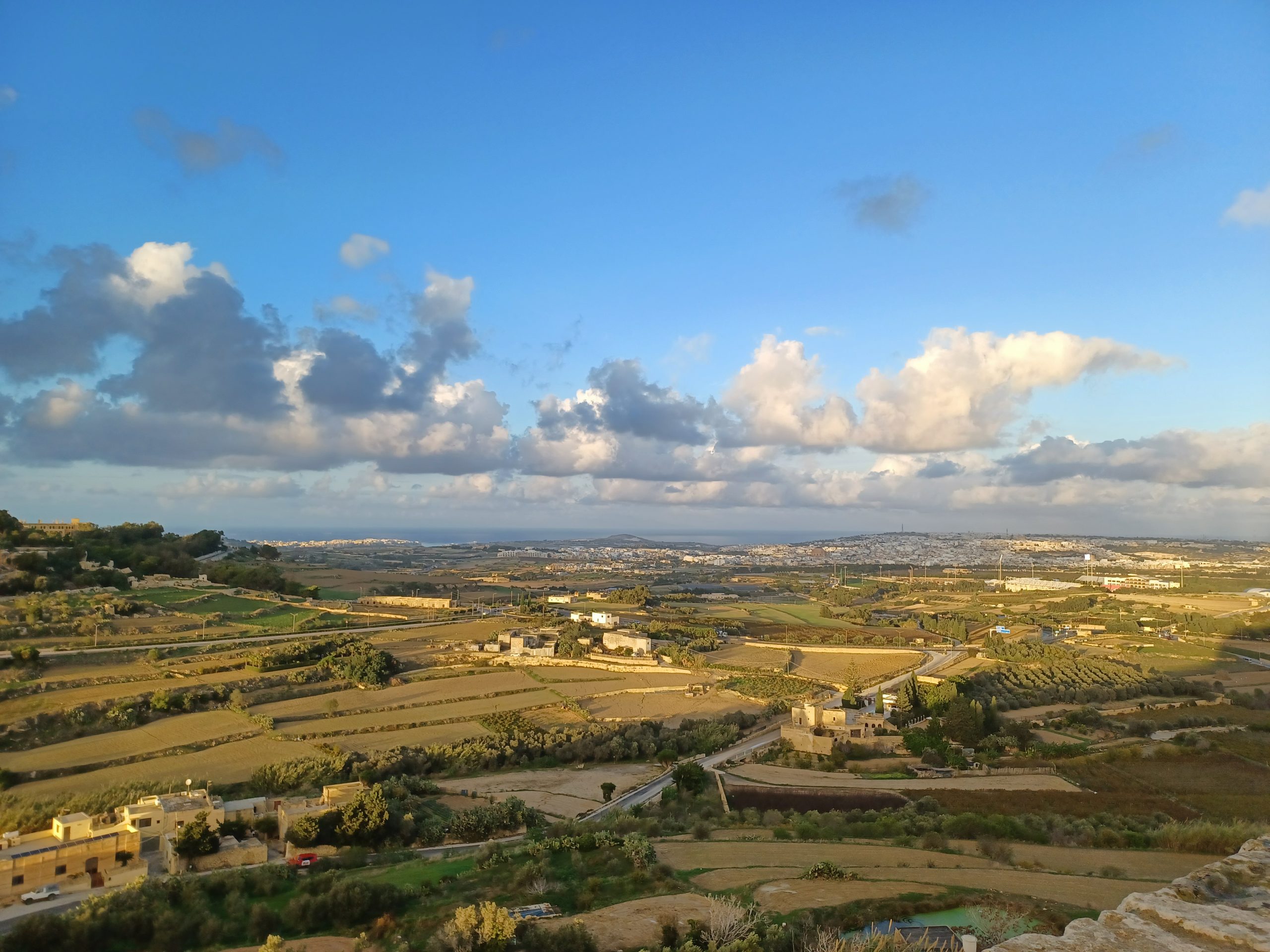
A karozzin ride
Mdina’s walled city echoes to the clip clop of the karozzini. These traditional horse drawn carriages take tourists through Mdina’s cobbled streets or into the adjoining town of Rabat. We know that the price of hiring a karozzin can be a trifle excessive but we take one anyway. The horse is harnessed and blinkered and the carriage hung round with drapes and a canopy with golden tassels. We ride from Mdina’s ancient gate across a bridge over the deep moat into Rabat. The seat is rather hard and visibility somewhat obscured by the driver and it is a bit chilly too. The driver, not as well turned out as his horse, is supposed to provide some information about the sights along the way but not much is forthcoming.
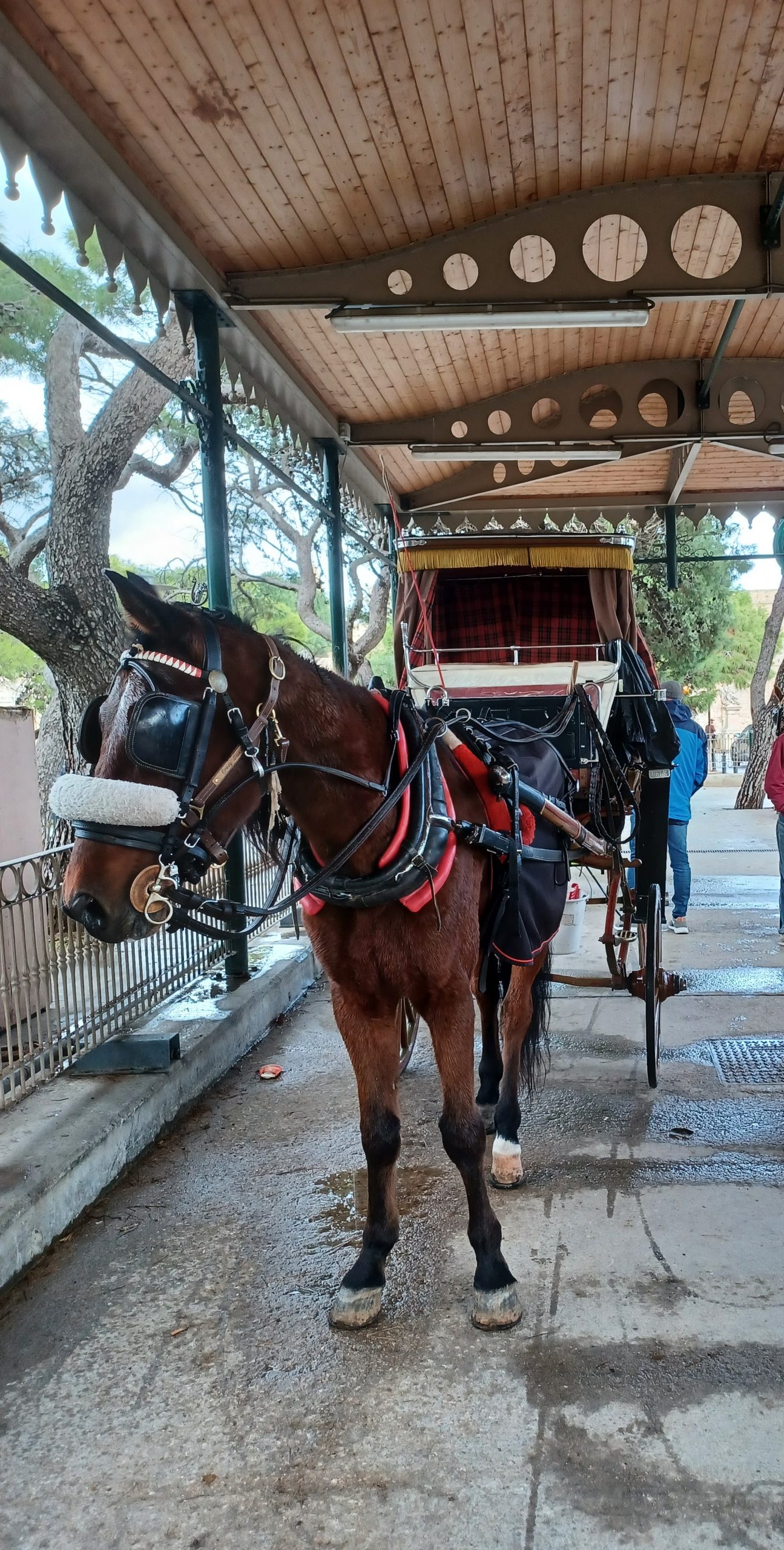
Anyway, he is far too preoccupied avoiding the traffic, including a bright old yellow, orange and white bus. There are several of these old buses still in use in Malta, some of which date back to the 1950s and are mostly of British manufacture. The one we see is a Fordson Thames ET. Most have since been replaced by a modern and, in my opinion, less attractive, Chinese fleet. There was somewhat of an outcry when it was decided by the authorities to scrap these old buses. As in UK though, with steam engines and vintage vehicles, enthusiasts quickly stepped in to rescue and restore them. There are other vintage British vehicles here too. I spot an old Ford Anglia. My grandfather had one of those, a light blue one.
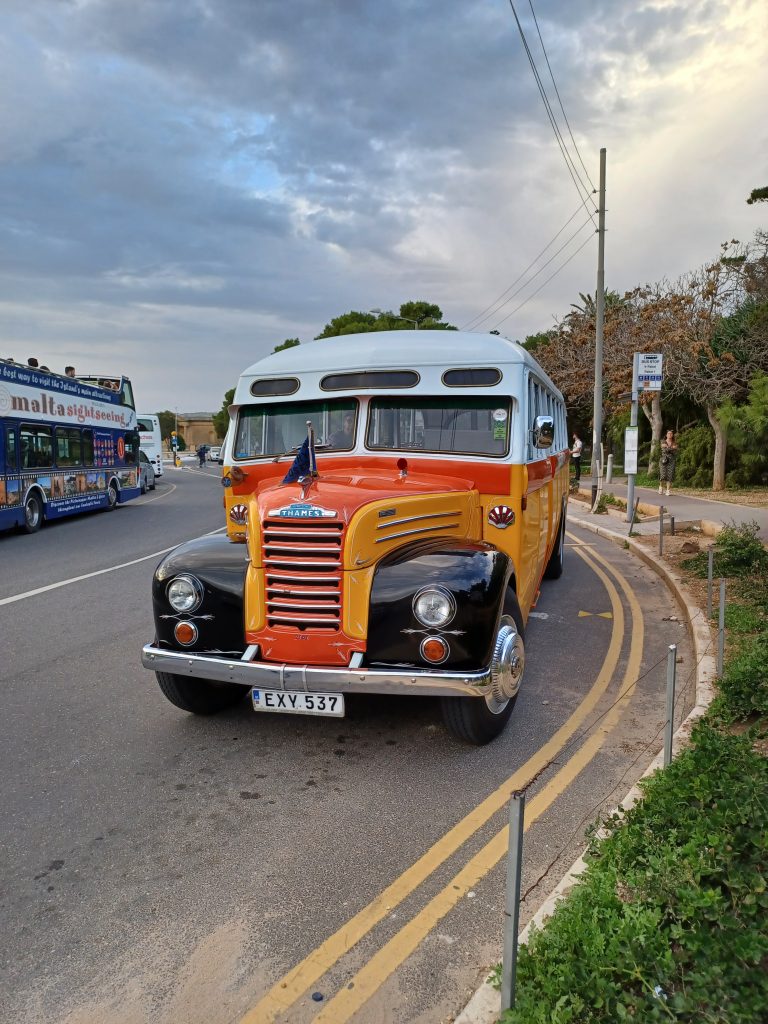
We clip clop past the entrances to some ancient catacombs, and make a mental note to visit. We pass St Paul’s Church and the Wignacourt Museum and many old stone buildings with enclosed balconies of painted wood: greens, blues and reds with glass windows, called ‘gallariji’ in Maltese. The origins of these are, apparently, the Arabic buildings of North Africa, out of which the women could peer but not be seen. The more common, not enclosed, balconies are made of stone with elaborate carved corbels and balustrades. Other architectural gems include enormous decorated door knockers in various designs, such as fish or lions’ heads, or the eight pointed Maltese cross. I gather that, in times past, the wealthier you were, the bigger your door knocker. Our ride over, we thank the horse and cross over the large moat, which now contains neatly laid out gardens, into Mdina on foot.
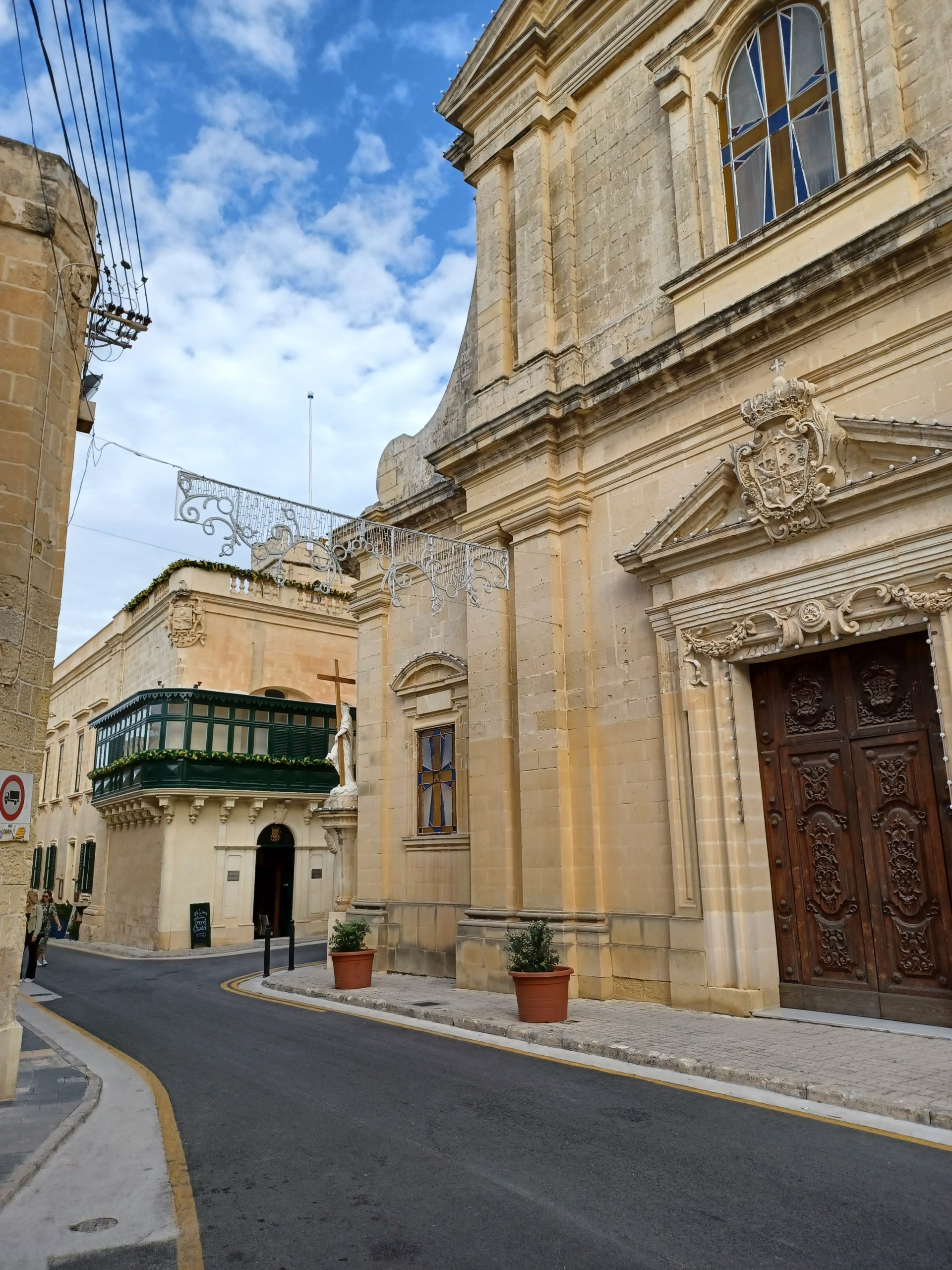
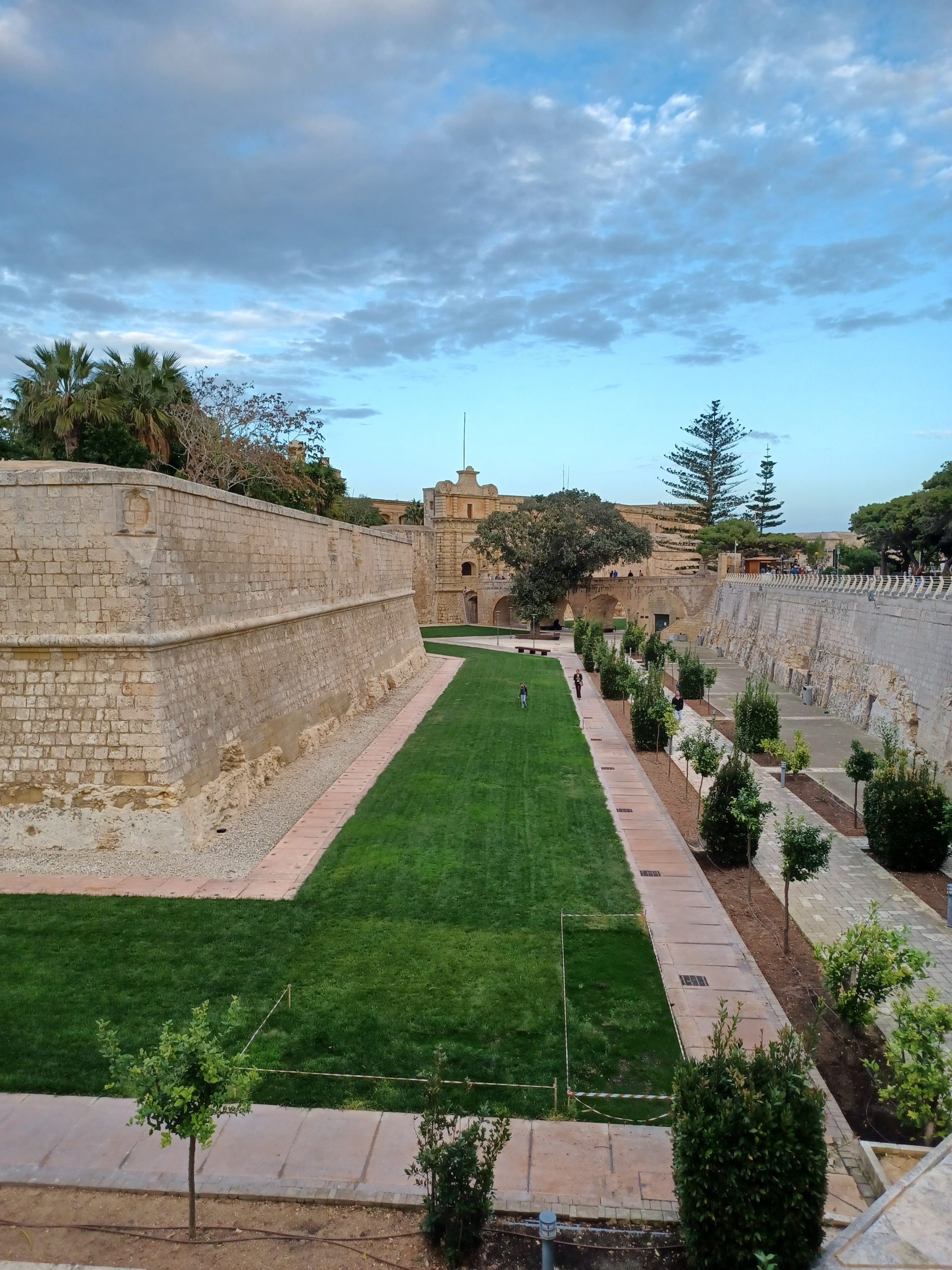
St Paul in Malta
Within Mdina’s walls is St Paul’s Roman Catholic Cathedral, a splendid baroque edifice dedicated to St Paul, who was ship wrecked off Malta in 60 AD, and brought Christianity to the island. It is said that the Roman Governor of the time, Publius, welcomed St Paul and that his house was located on the site of the present Cathedral. We pop in through the doors and stand at the back with some other visitors looking at the colourful interior. Frescos of St Paul’s life are depicted on the ceiling and the floors are covered with the marble tombstones of Maltese gentry and clergy, some of which depict colourful coats of arms, animals, weapons and more ‒ quite unlike the grey gravestones and sober looking monuments in UK. Why is it that our memorials to the departed are always so devoid of colour I wonder? Choral music is playing softly and contributes a good deal to my sense of the spiritual.
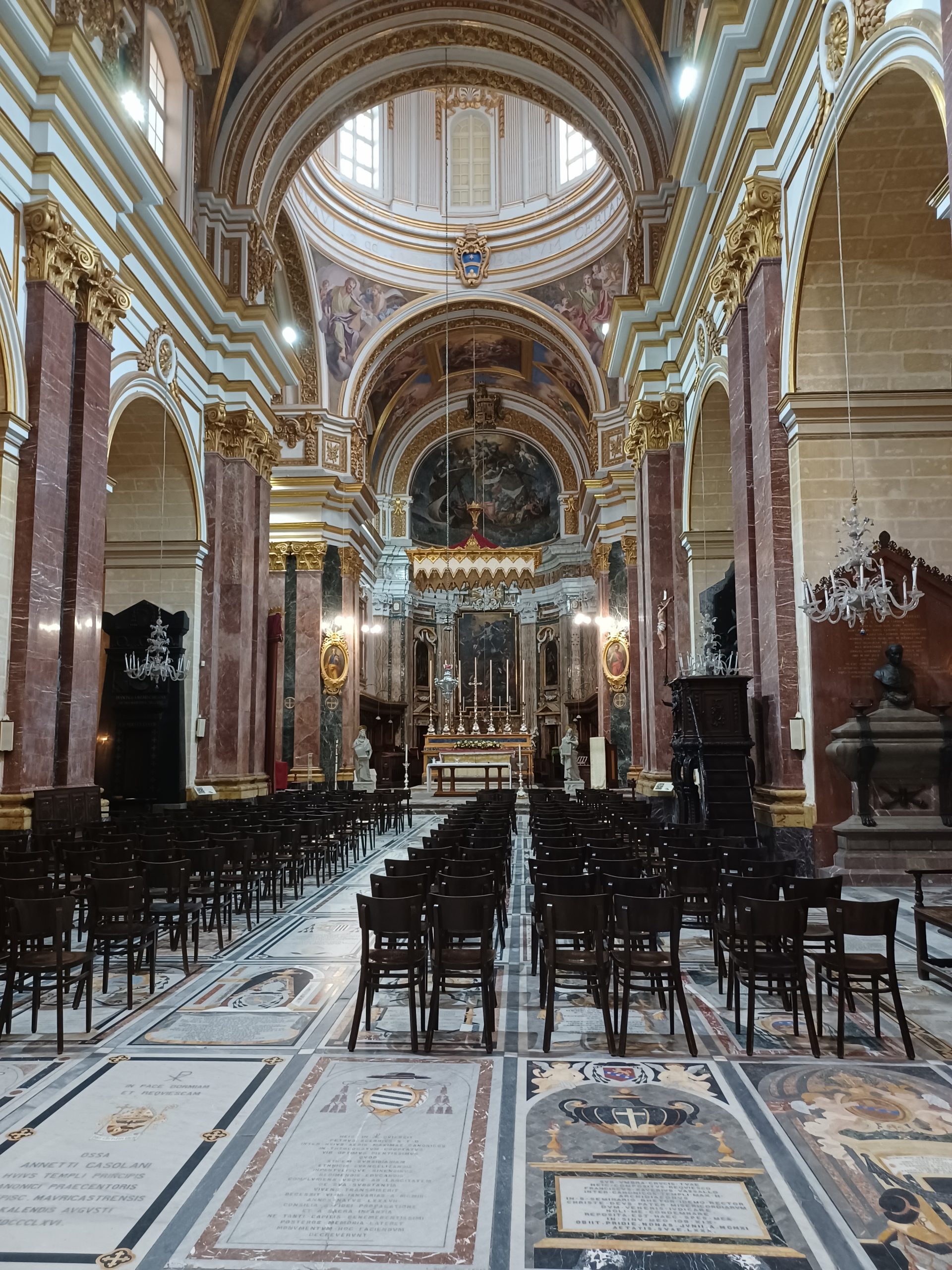
Talking of St Paul, he is said to have preached in a grotto in Rabat during his stay in Malta. This grotto would be worth investigating. Placards on the outer walls of St Paul’s Basilica reveal that there have been visits to the grotto (which is underneath) by all three of our recent popes, Popes John Paul II, Benedikt XVI and Francis. Pope Francis, for example, visited in April 2022 and left a prayer to the people of Malta on the wall, thanking them for their humanity and kindness in welcoming St Paul after he was shipwrecked. We also descend into the grotto. It is rather humble and contains a statue of St Paul with a couple of lanterns either side of it. Guardians for the grotto were provided by the Knights of St John, who had first come to Malta in the 1500s and established hospitals here for pilgrims to the Holy Land. The chaplains of the Knights of St John resided in what is now the Wignacourt Museum, named after Alof de Wignacourt, who became Grand Master in 1601. This museum is linked to the grotto.
Catacombs and air raid shelters
Under the museum are Roman catacombs which were used as air raid shelters in WWII during the siege of Malta in 1940-42. These were able to accommodate hundreds of people. We descend into them and saunter through long winding white corridors. It is a bit chilly down here, so we do not tarry long before seeking out the charming café in the museum garden. Apparently, during the war, an oven was based in this garden, providing 2000 loaves of bread per day for the local population. We choose a table alongside an old stone well with a few plants scattered about. A cat sidles by and places itself on the warm stones. My friend sips his beer under a pomegranate tree, from which one could easily pluck a fine fruit but don’t, and the sun filters between its branches.
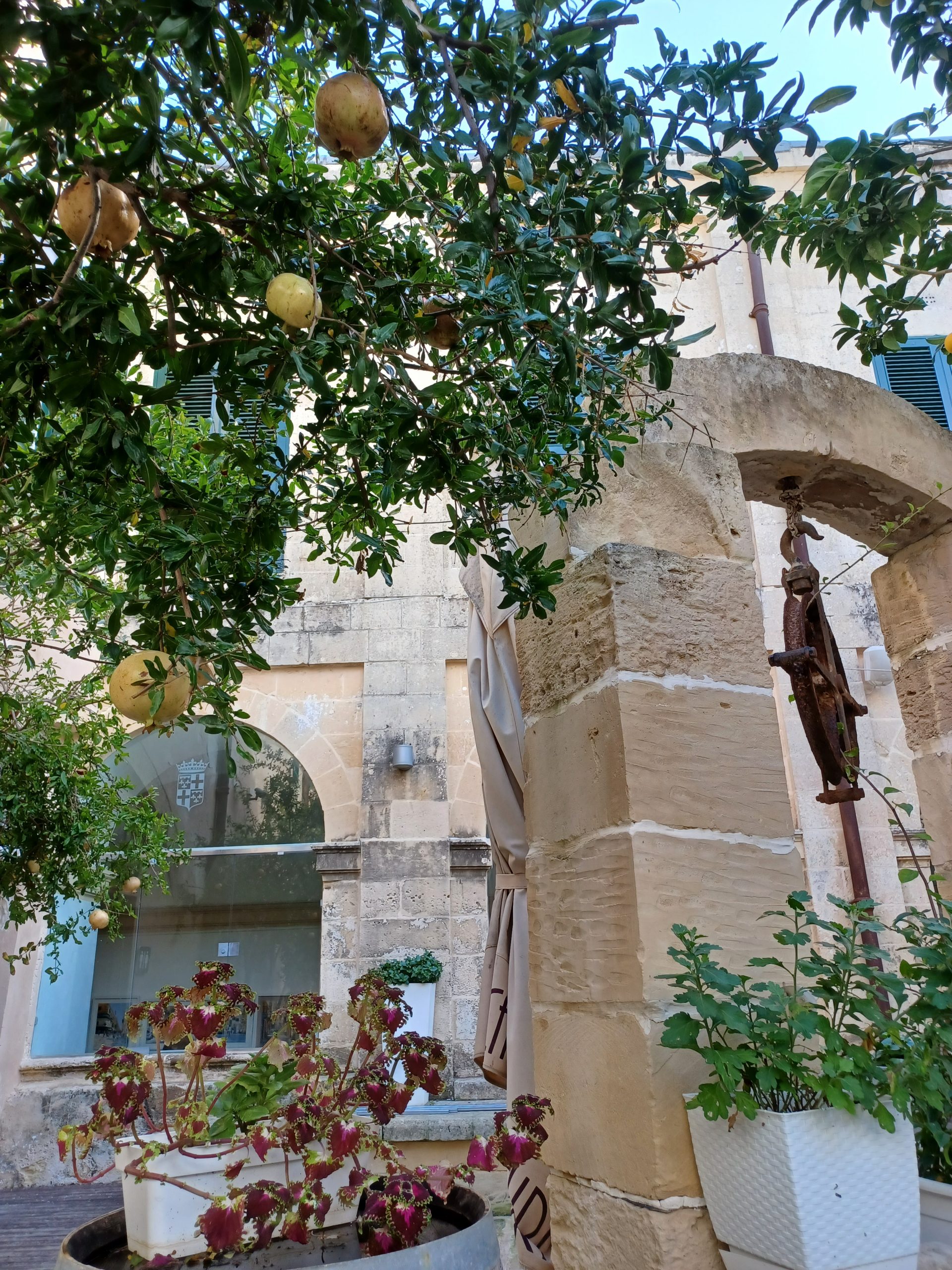
Catacombs of St Agatha
I am a bit fascinated by catacombs, so coax my friend, not so fascinated, to visit more of them. We opt to view those of St Agatha, also in Rabat. St Agatha was an early Christian martyr who, legend has it, sought refuge in these catacombs in the days when persecution of Christians was rife, hence the name. An elderly gent turns up at the entrance. It is his lunchtime break, but he nevertheless agrees to show us round. Most obliging. The main hallway contains ancient frescos, which he describes to us with some enthusiasm. We are then led through narrow passages, up and down uneven steps where there are tombs. It is a bit claustrophobic down here and some of the tombs have skeletons still in them staring at you as you pass. “There are over 1000 tombs here”, we are told. “This chapel is the most important place,” says he, as a rock cut chapel appears in front of us. The chapel contains an altar, where the Eucharist was held, and a fourth century fresco which depicts the Chi-Rho, an early Christian symbol formed by combining the first two letters of the word ‘Christ’ in the Greek alphabet. We are then shown a large stone table hewn from the rock, called an agape table. “The families of the deceased used to share a meal ‒ an agape feast ‒ around this table to commemorate their relative”, our guide informs us. I have never heard of those before.
More ancient sites beckon. Just outside the bastions of Mdina in Rabat are the quite extensive ruins of an old Roman house, the Domus Romana, located within what once was the Roman city of Melite. Inside are fine mosaic floors, one in the central courtyard featuring two doves at its centre. Heritage Malta built a museum around them with a neoclassical façade. We go in. There are many fragments of statues and artefacts on display and the courtyard is surrounded by restored Doric columns. An interesting diversion, and, as it has become jolly cold outside, we are content to wile away the time indulging in history.
The evening meal is spent in a local restaurant where rabbit is on the menu. Rabbit, particularly in its stewed form, ‘stuffat tal-fenek’, is a favourite dish in Malta. They were introduced by the Phoenicians over three thousand years ago, probably as the environment is not that conducive to supporting other livestock. Goes down well.
Valletta
No trip to Malta can be made without visiting Valletta, the island’s capital. The Knights of St John built huge fortifications here, especially around Grand Harbour following the Great siege of 1565 in which the Turks were defeated. Valletta is one of UNESCO’s World Heritage Sites and is full of historic buildings plus the odd red telephone box.
Siege of Malta WWII, and British Forces post WWII
Less than 400 years after the Great Siege came another siege of Malta in 1940-1942, in which the Italian Air Force and German Luftwaffe bombed the British forces based here. The island was ruled by the British at that time (altogether for about 150 years until its independence in 1964), and was in a strategic location in the Mediterranean. From here the British forces were able to attack the shipping of the Axis powers who were resupplying their forces in North Africa. In an attempt to thwart these attacks, the game plan of General Erwin Rommel, (the ‘Desert Fox’), was to bomb Malta into submission. Most of the bombing carried out was over the densely populated areas of Valletta and the three cities of Vittoriosa, Senglea and Cospicua round the Grand Harbour. Some evidence of the bombing still exists, for example, the once Royal Opera House in Valletta, which took a direct hit by the Luftwaffe in 1942, stands to remind visitors of that time. The shell of the building remains with a few of the old columns still standing and it is used for open air performances. The green plastic seats, which have been put inside, look a little out of character I think.
After the allied victory King George VI awarded the George Cross to the whole population of Malta in recognition of their valour. Hence the cross of St George is displayed in the white canton of the current Maltese red and white flag.
We take refreshments in the café alongside the opera house. Arancini – those Sicilian breaded risotto balls – are rather good. We devour them at leisure, whilst watching the people pass by on the main thoroughfare of Republic Street. It is warm and we lounge here a while before walking the short distance to see the Auberge de Castille, which used to house the British Army headquarters and the Officers’ Mess. This is an impressive looking baroque building situated on the highest point on Valletta overlooking Grand Harbour. It has coats of arms on the façade and roof and old cannons at the top of the steps pointing outwards. It too was bombed during WWII but the damage was repaired, unlike the Opera House. My friend peers through the doorway, where a sentry stands, remembering that he once went in and out of there during his time in the Army. The Auberge was originally built for the Order of the Knights of St John, later it was the HQ of the French forces under Napoleon, who defeated the Knights in 1798. The French only held the country for two years. First Maltese insurgents rose against them and then they were forced to surrender to the British in 1800. Today the Auberge houses the office of the Prime Minister of Malta.
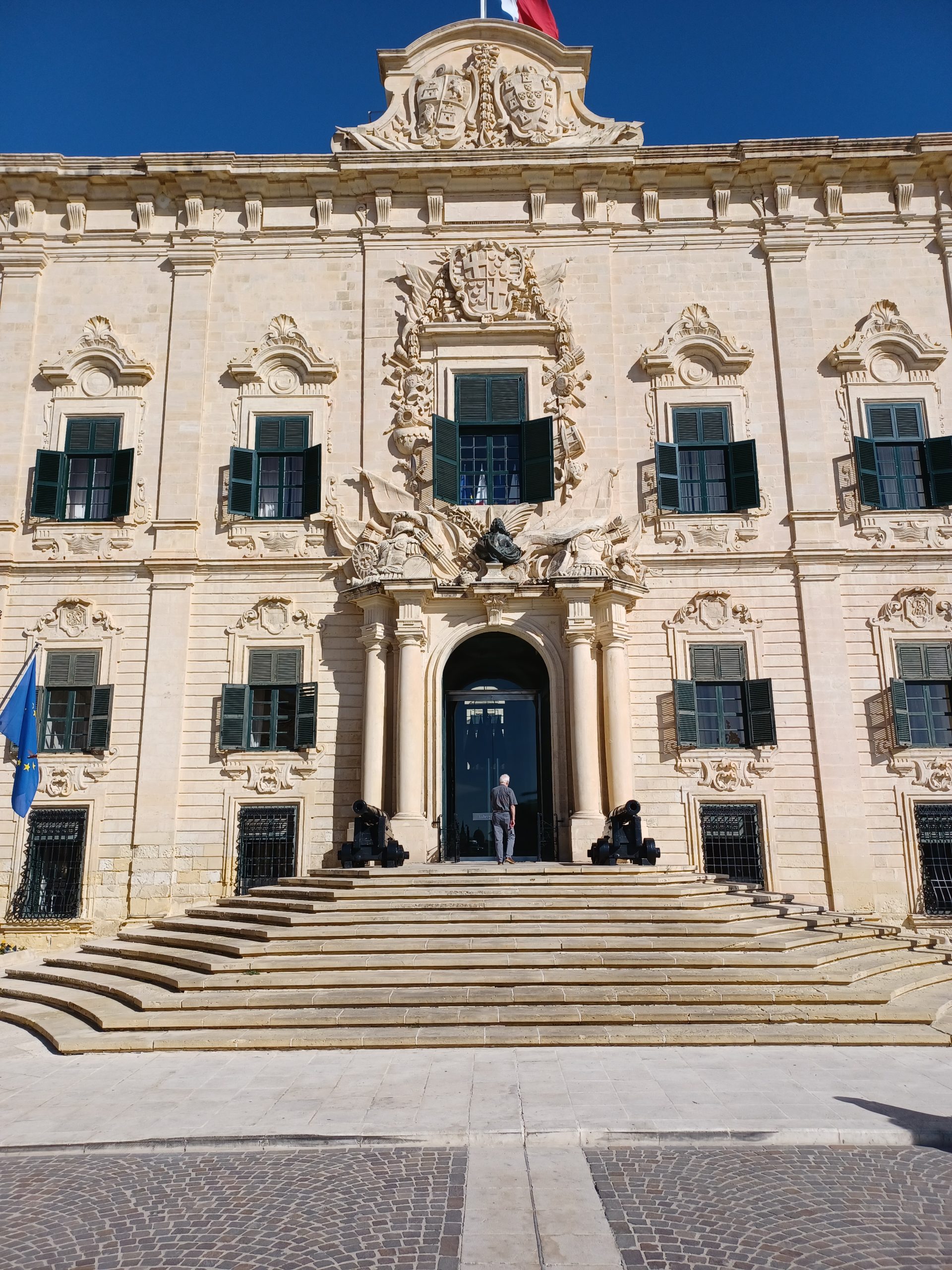
It is now time to head to the water. My friend and I had both spent time aboard various vessels in Malta in the past, so a further nostalgia trip is in order. We take a bus into Sliema. Opposite the waterfront across Sliema creek is Marsamxett harbour and the wharf where the Army boats were once based, operated by the Royal Corps of Transport. My friend had been happily in charge of three launches at Hays Wharf in Marsamxett harbour before Malta’s independence. Adjoining the Sliema waterfront is the town of Gzira and it was in the marina here where a replica of Sir Francis Drake’s flagship, the galleon ‘Golden Hinde’, had once moored up during its round the world voyage. I had been a crew member in my youth and had spent time in this marina oiling blocks and tarring rigging. It all seems very busy now with lots of traffic round about. I don’t recognise anything. I don’t even remember crossing the creek to Valletta, which I must have done. Memories are fickle.
Boat trip: Grand Harbour and the 3 Cities
Wandering along the seafront, happily looking at boats, we are accosted by a boat tout, plying for custom for the last cruise of the day. “Harbour cruise, Sir? Madame?” “Lovely trip round Grand Harbour and the three cities?” It is already 1600 hours, the sun is nearing the tower tops. But the weather is kind, the wind gentle. “Why not?”, says my friend. And we board the boat with a few others. As the next day was to bring brooding clouds, rain and gales, this is a smart decision. The cruise takes in the ten creeks, which include the three cities around Valletta’s Grand Harbour, reached from Sliema by rounding Fort St Elmo on the end of the peninsula. It is the best time of day, the water is glassy, the sun casts long shadows. Photographers rejoice.
As I have elsewhere mentioned, seeing a city from the water gives the traveller a wholly different perspective (See travelogue on France: Waterways of Burgundy). We note the clusters of buildings all vying for a view of the water, the marinas full of sailing boats and motor cruisers bobbing about. We pass a sleek white super yacht. Wonder who owns that.
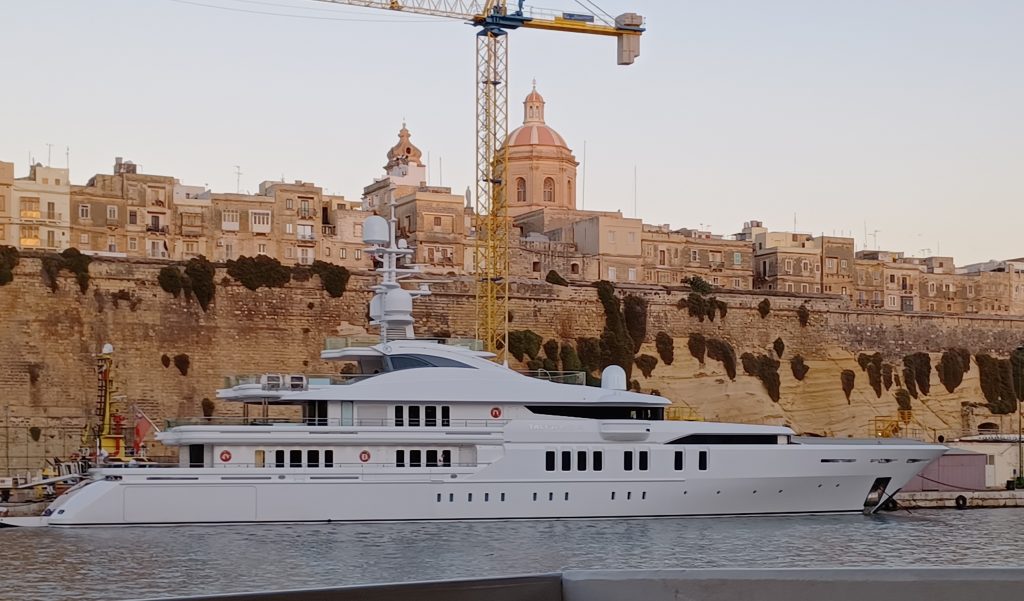
The imposing Fort St Angelo hoves into view atop the cliff at the tip of Vittoriosa. The late sun warms the soft stone of the fort, its rays bounce off the domes of the churches and shimmer off the lazy ripples. The recorded voice over the boat’s sound system informs us that Fort St Angelo was used as the headquarters of the Order of the Knights of St John during the great siege of Malta. Later it was occupied by the French and then garrisoned by the British. It has been restored now and is a tourist attraction, although the upper part of it, states the voice, was given to the Order of the Knights of St John in the late 1990s for 99 years.
Heading towards Sliema Creek again we are slowed down by a late afternoon shoal of school dinghies, the young helmsmen of which clearly have no idea of the rules of the road. They are tacking across the bows of our boat, their little white sails flapping as they turn about. The captain slows down. They move off, ripples glowing in their wake. Floodlights light up the Dome of the Carmelite church of Our Lady as the sun sets and we approach our mooring.
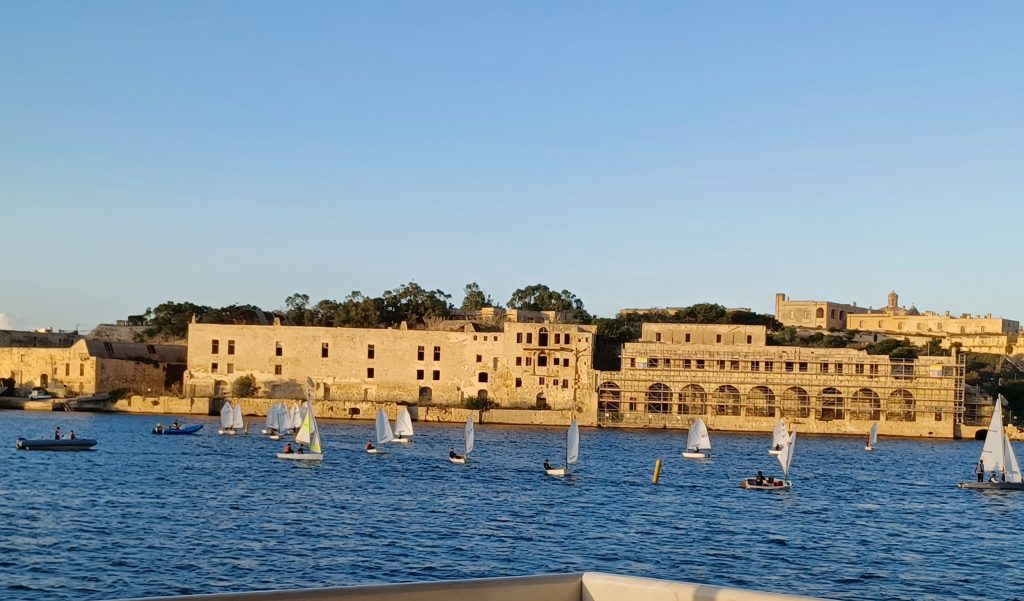
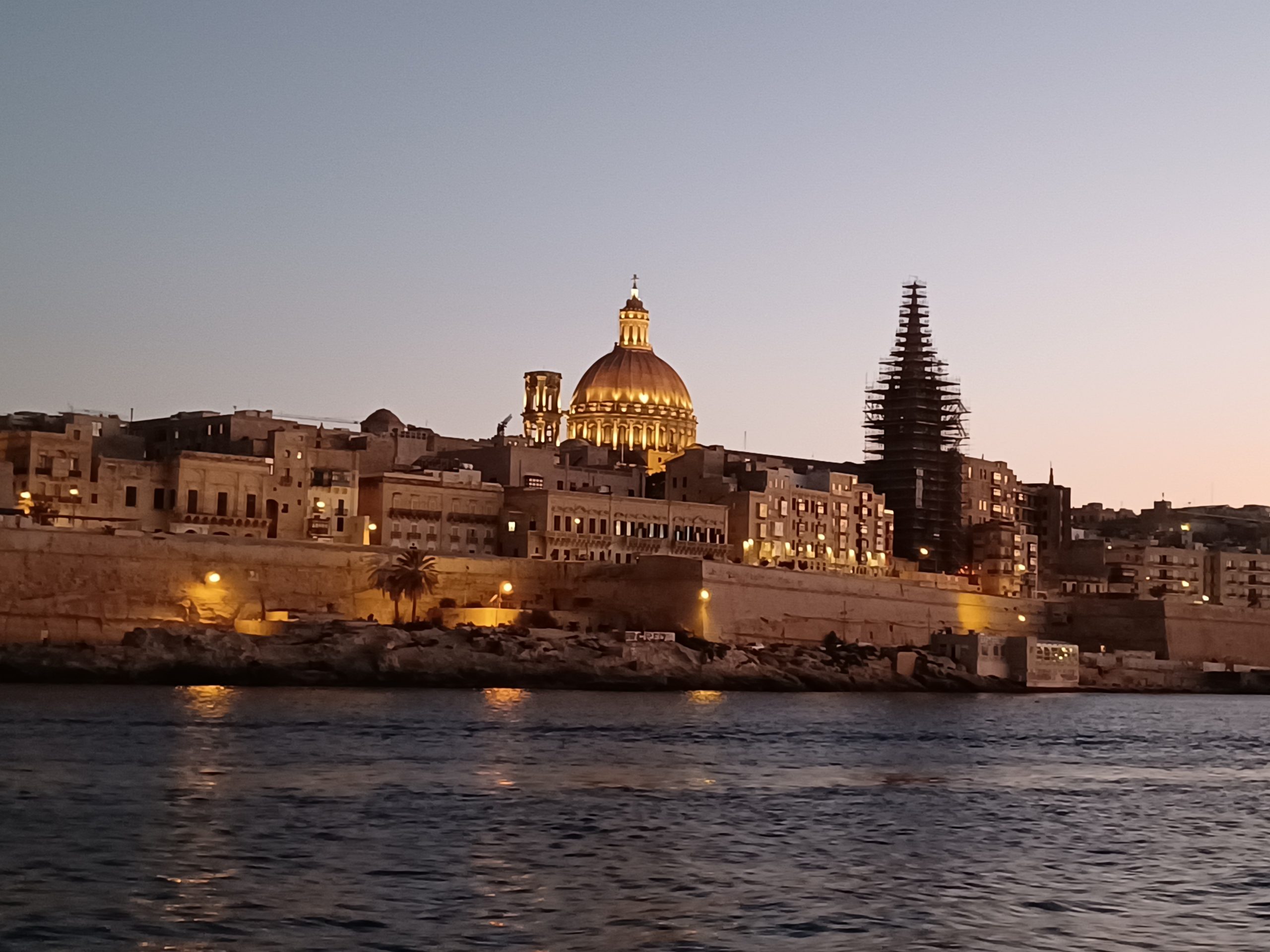
A drive round Malta
Rotunda of Mosta
We have so far traversed the island by bus, boat, and karozzin but now wish to explore some other areas independently. A hire car is on the agenda. One of the foremost places we want to see is the Rotunda of Mosta or the ‘Sanctuary Basilica of the Assumption of Our Lady’. This Catholic church, one of about 360 in Malta, was modelled on the Pantheon in Rome, and is visible right across the island. It was completed in 1860 and built around an older church, when the latter had apparently become too small for the increasing population of the parish.
We arrive in the rain, the dim morning light shining off the puddles on the concourse. The façade of the building features twelve columns and twelve statues of the apostles. A belfry rises each side of the massive dome, which is nearly 40 metres in diameter. The guide book claims that it is the third largest unsupported dome in the world. We enter and gaze up at the ceiling, which is covered with gold painted Marian roses. Around the interior are several chapels with paintings portraying the life of Christ between the arches. It is bright and beautiful. We venture up the stone spiral staircase to peer down from the gallery onto the vast space beneath. The only activity is a painter/decorator atop a platform lift, who is touching up the paintwork above one of the chapels, while one or two tourists wander about.
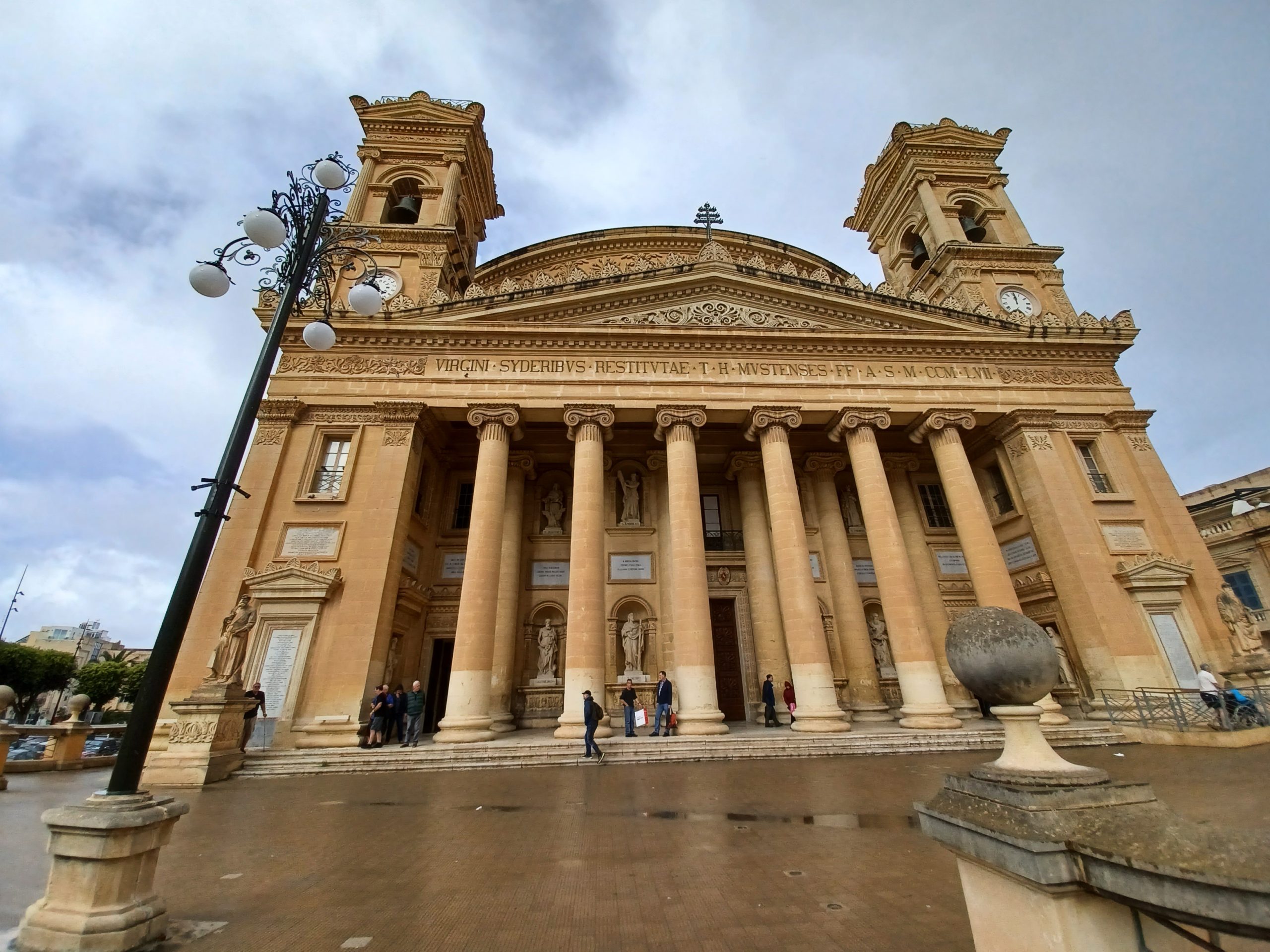
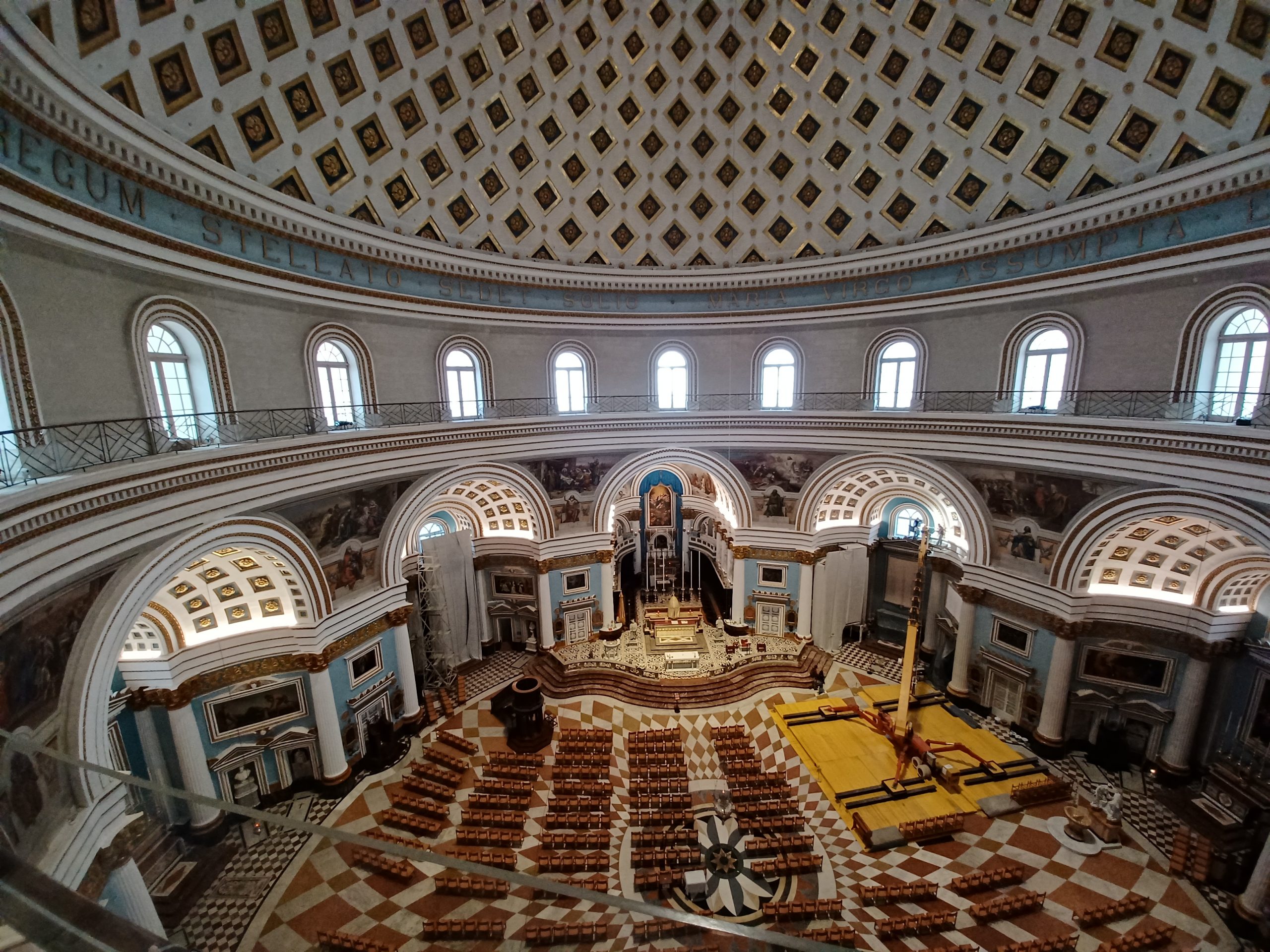
One of the Rotunda of Mosta’s claims to fame is the fact that during WWII, on 9th April, 1942, the Basilica was bombed by the Luftwaffe. The 300 or so members of the congregation were in the middle of a service, when the dome was pierced by an 1100 pound bomb, which did not explode. Nobody was killed and the dome did not collapse. This ‘miracle’ is celebrated every year on that date. The Sacristy contains a monument to the event with a replica bomb with the Virgin Mary above it, shown protecting the church.
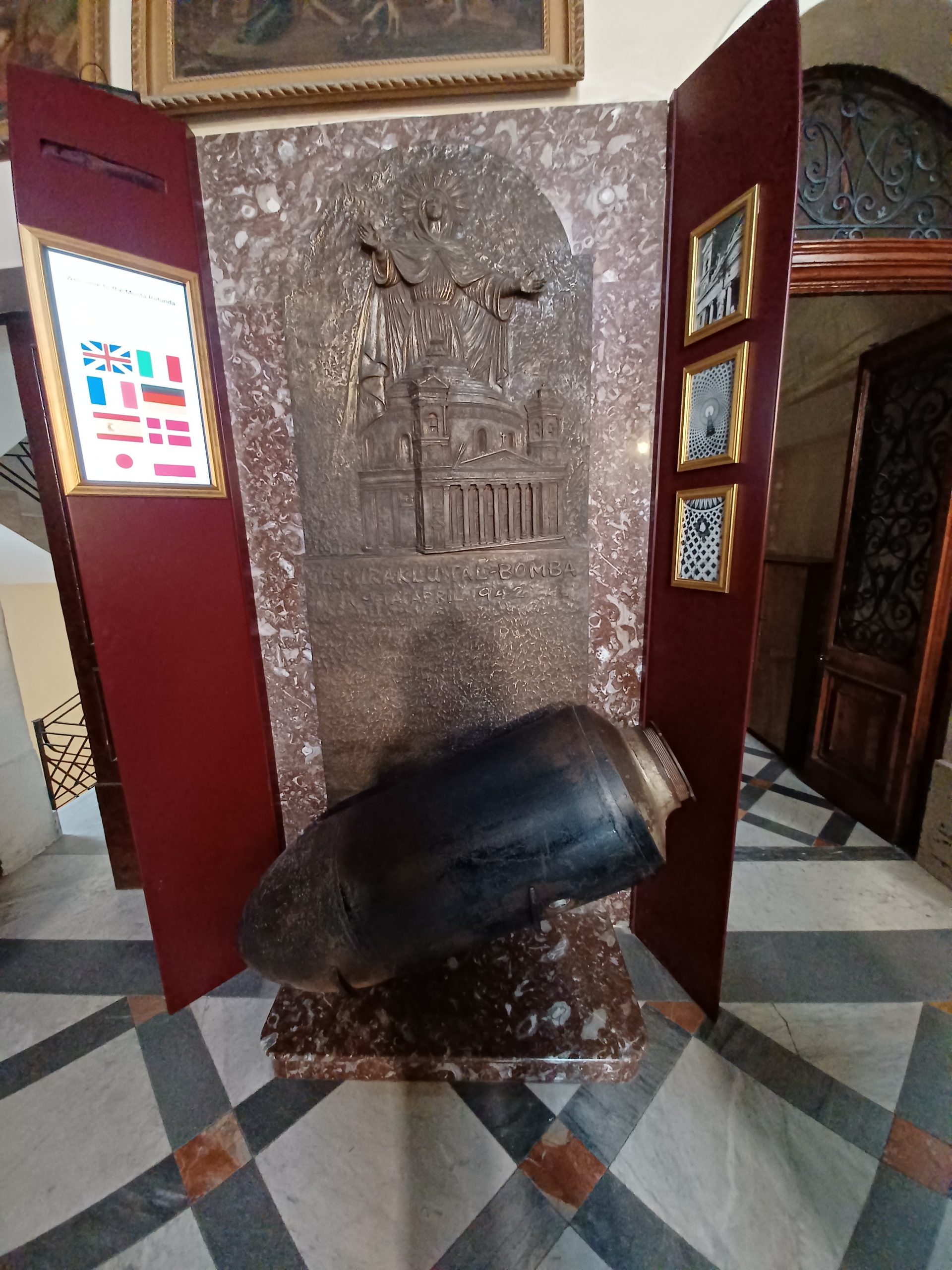
Watch towers built by Knights of Malta
It is still drizzling as we leave and continue our drive. The aim is to find the living quarters of the British forces in the last years before independence, along Malta’s north-east coast. All we see are ghosts of once inhabited buildings, looking unkempt and sad in the gloomy weather. My friend barely recognises them. Further on, St Paul’s Bay, viewed from the Wignacourt tower, a fortified stone watchtower built in the 1600s, would look a lot more enticing in the sunshine, but there is none, and we eat a hasty lunch outdoors under a canopy in the cold rain and wind.
Glad to retreat to the relative warmth of the car, we drive across the island from north-east to north-west where we see a number of other forts and watch towers built by the Knights of Malta. We brave strong winds to walk out to the Ghajn Tuffieha Tower, built in the 1630s, overlooking a stunning bay with a lovely sandy beach, huge waves surfing up it. Ghajn Tuffieha means ‘Apple’s Eye’ in Maltese. Nobody is on the beach today. It would be tricky to descend the long flight of steps down the cliff to access it in the present wind. I read a news clip a short while after our visit, which stated that the tower had been damaged in a storm during which some of its masonry collapsed.
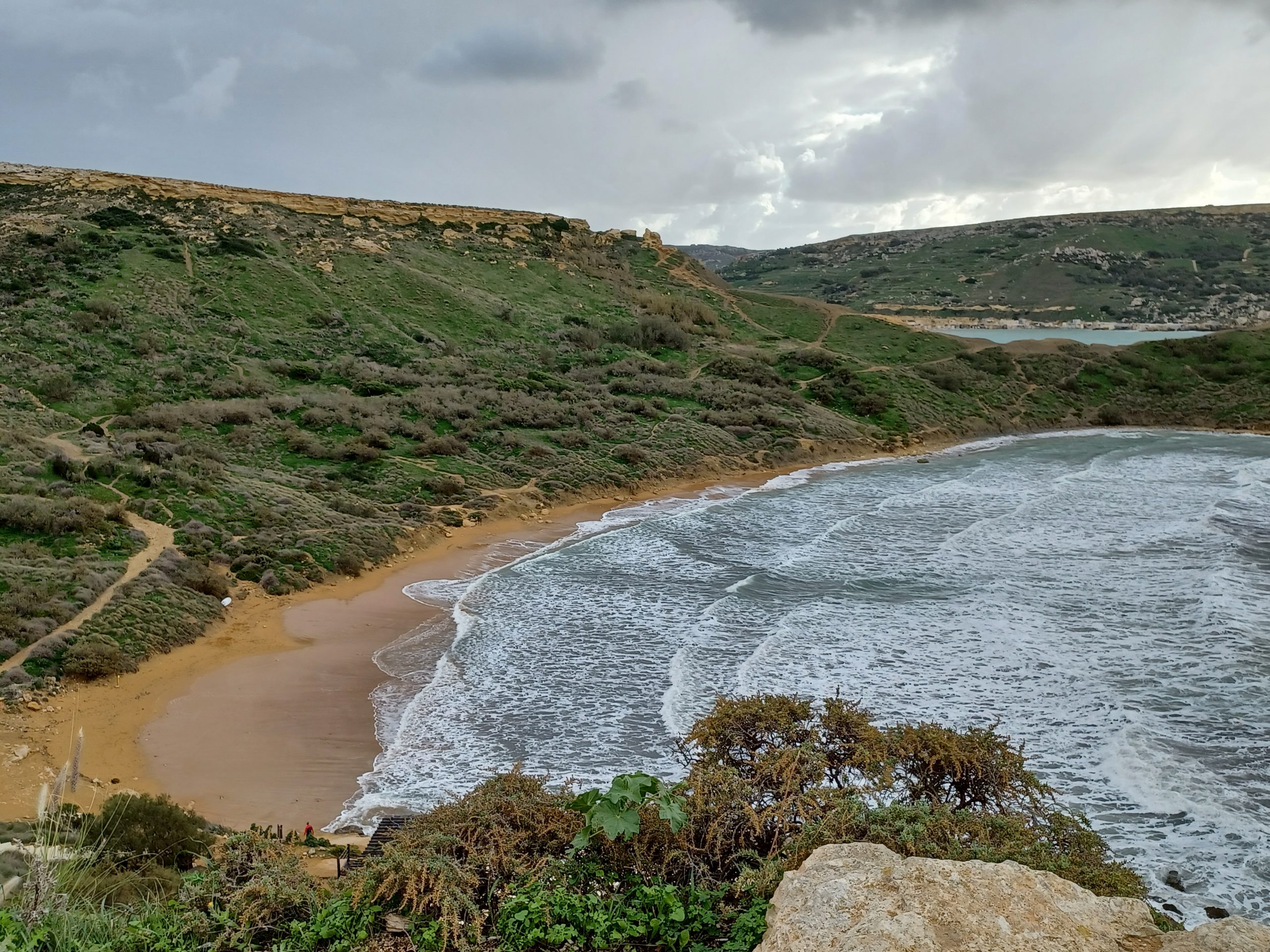
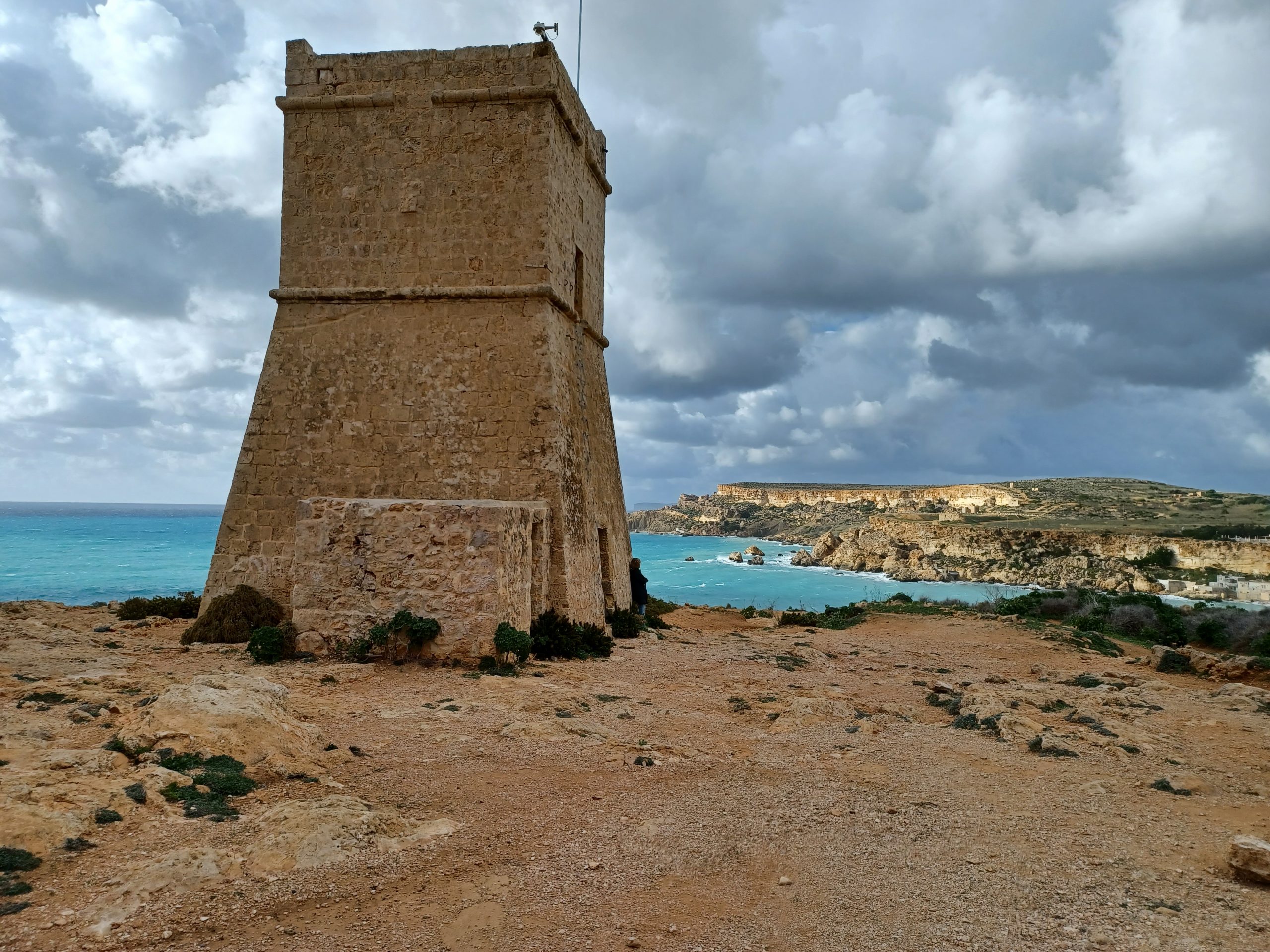
The sun eventually peeps out as we weave our way through the whitish rocky landscape dotted with cacti and small trees, chapels and whitewashed houses, and the odd horse. We pass a section of the line of fortifications built by the British and known as the Victoria Lines, in honour of Queen Victoria’s diamond jubilee in 1897. We stop briefly at a lovely old stone chapel behind the lines. It is closed. A stonechat flutters briefly onto a fence post and, for a while all is calm and serene before we approach Mdina and the traffic of Rabat from the north.
Night is falling. In the daytime Mdina is full of tourists but at night time most are gone and its silent streets are left to its inhabitants. Peaceful it is, wandering between the tall walls of the citadel and its old buildings but it is time to dine. Someone in the hotel had recommended a restaurant named ‘Bacchus’, located in an old gunpowder magazine, built by one of the Knights of Malta in the 1600s. We enter. A splendid meal is consumed therein along with some equally splendid red wine. Not Maltese wine though. We had tried that before and my friend noted that it had not much changed since he was based here in the late 1960s. It made one wince a bit.
Gozo
The island of Gozo, north-west of Malta, is next on our agenda. I remember when I visited before crossing over by ferry and enjoying the approach to Mgarr harbour in the warm sunshine. This time the crossing is so wild and the weather so cold that we spend the whole voyage inside the boat trying to prevent the table we are sitting at from sliding across the floor. Perhaps we should have turned back when we saw the waves crashing over the road at the ferry port on Malta but we didn’t. Thus, it is a hurried and chilly visit to Gozo but not without its high points.
St John the Baptist Rotunda Church, Xewkija
The first site of interest that we see from the road is another huge dome. We divert and find ourselves in front of St John the Baptist Rotunda Church in the parish of Xewkija. As with the Rotunda of Mosta, this church was considered too small for its congregation and a new one was built around the old one and completed in 1970. Apparently the whole community was involved in the building and funding of this church. The interior is of local white limestone with slender colonnades and arches, and decorated with artworks and a marble floor. A volunteer lady, full of enthusiasm, points us to the lift, which we take up to the roof and thence up an exposed spiral staircase into the bell tower. I like bells. There are six of them. I look closely at them and note that they were cast in England. There is a splendid view over the island from the tower, albeit visibility is poor with swift moving grey clouds. After descending we are told by the lady volunteer that the dome of St John the Baptist’s Rotunda is the third largest in the world, the same as is written about the Mosta Rotunda. I would not like to cast any shadow of doubt about this claim, so I don’t.
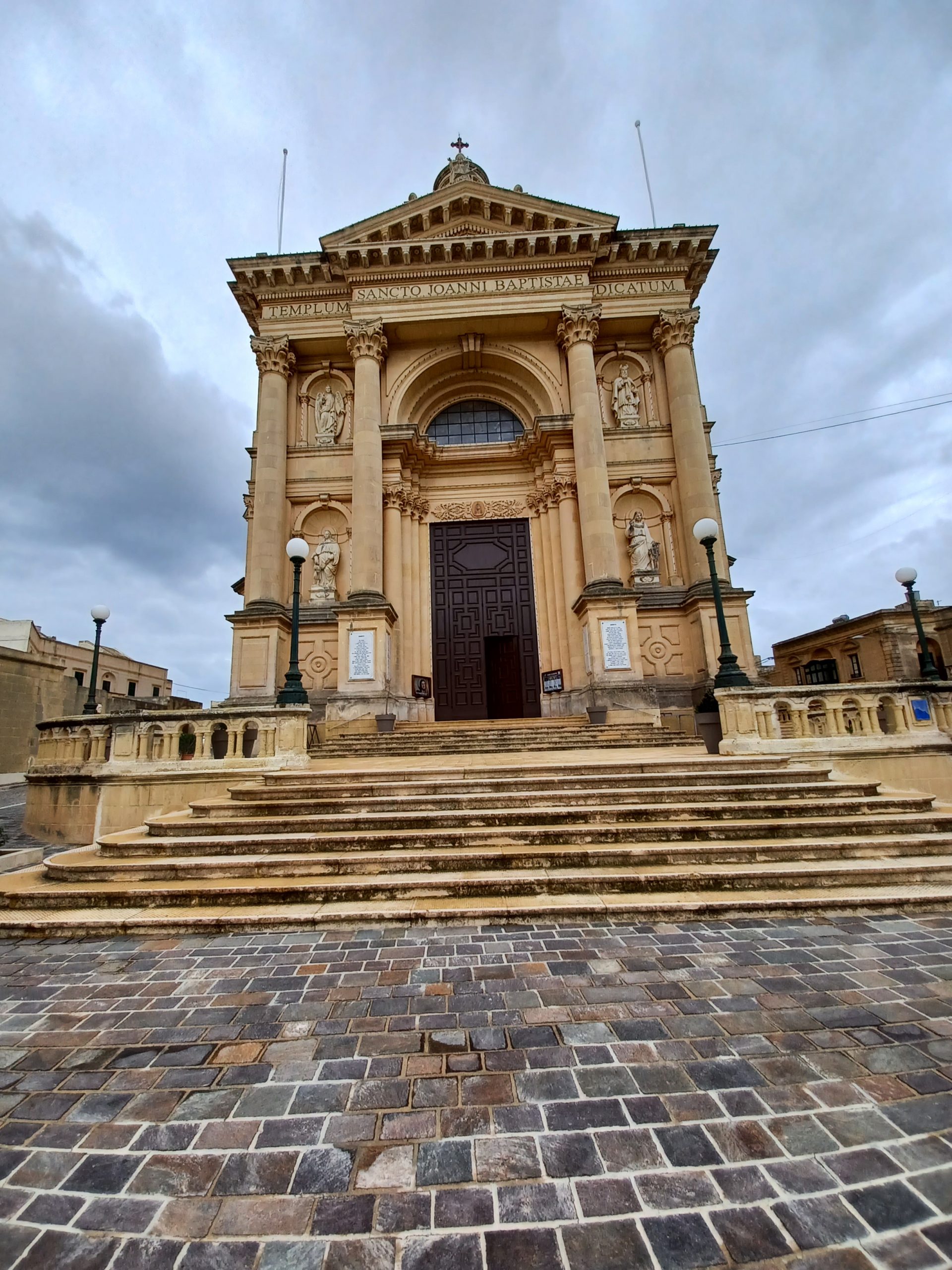
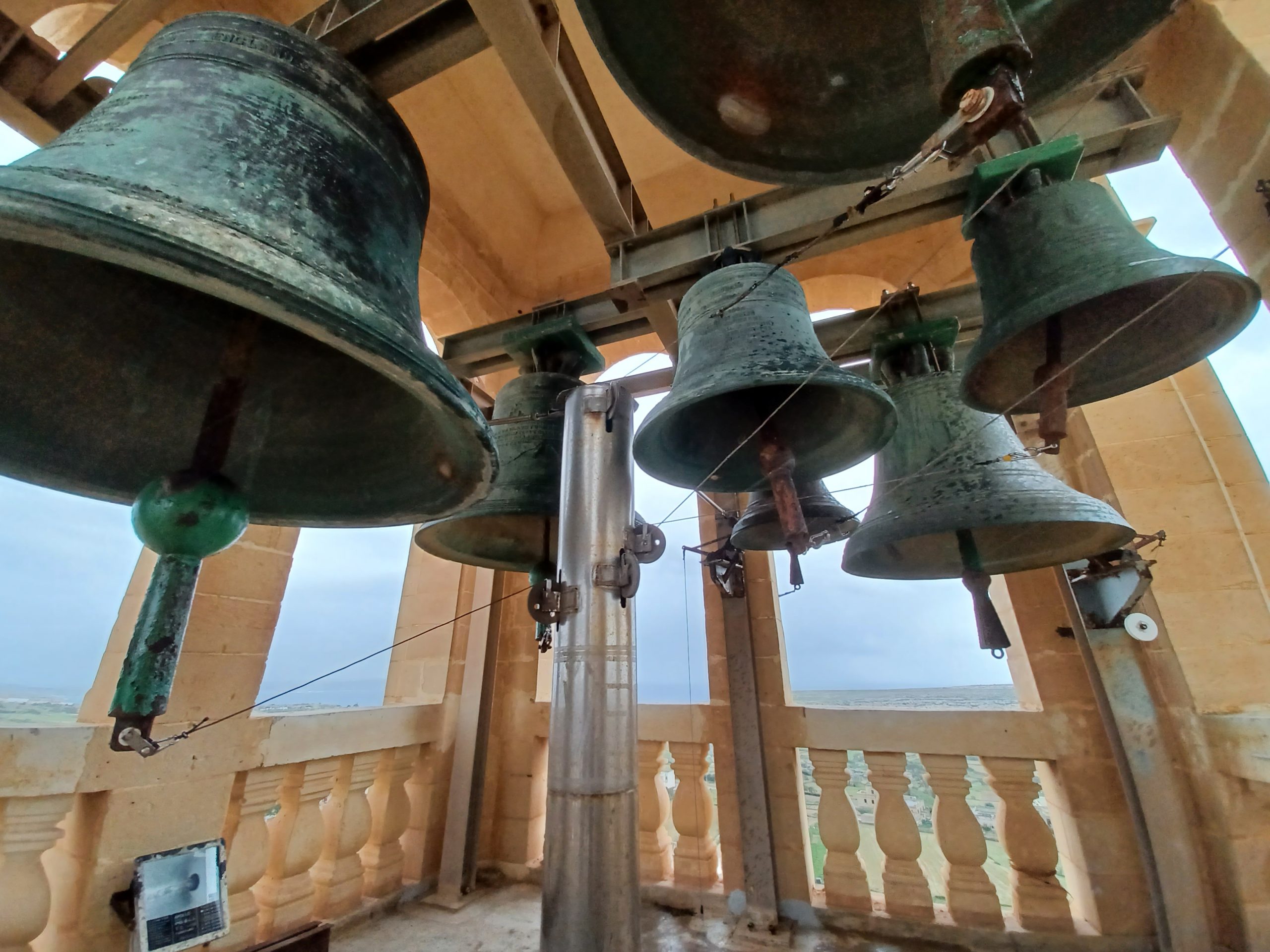
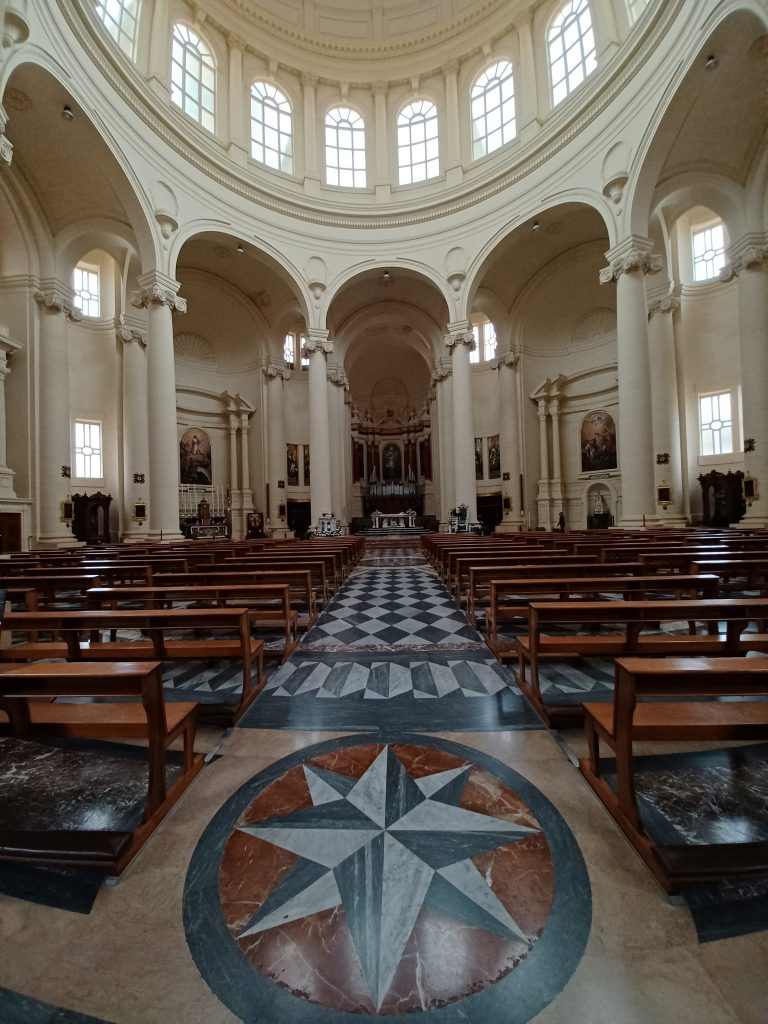
Victoria
Having braved thus far, we are obliged to see the main sights in Victoria, the island’s main town. Thus, we drive thither and, in the biting wind, hurry round its citadel, noting that our late HM the Queen and Prince Philip had toured it in 1992. Hope they had better weather. We do not linger long viewing the cannons and the cathedral inside the walls, splendid though it all is. One chap is wandering about wearing shorts.
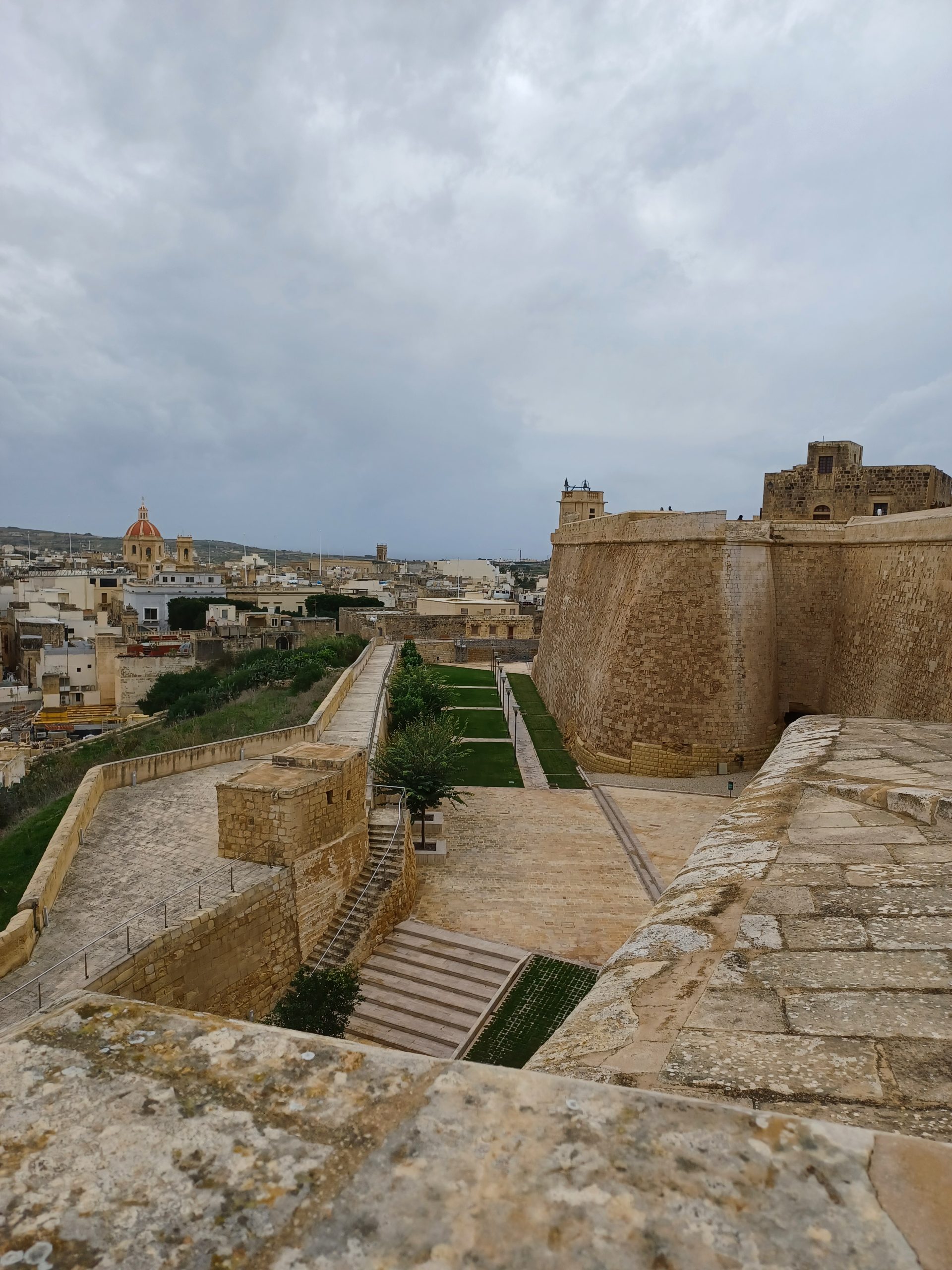
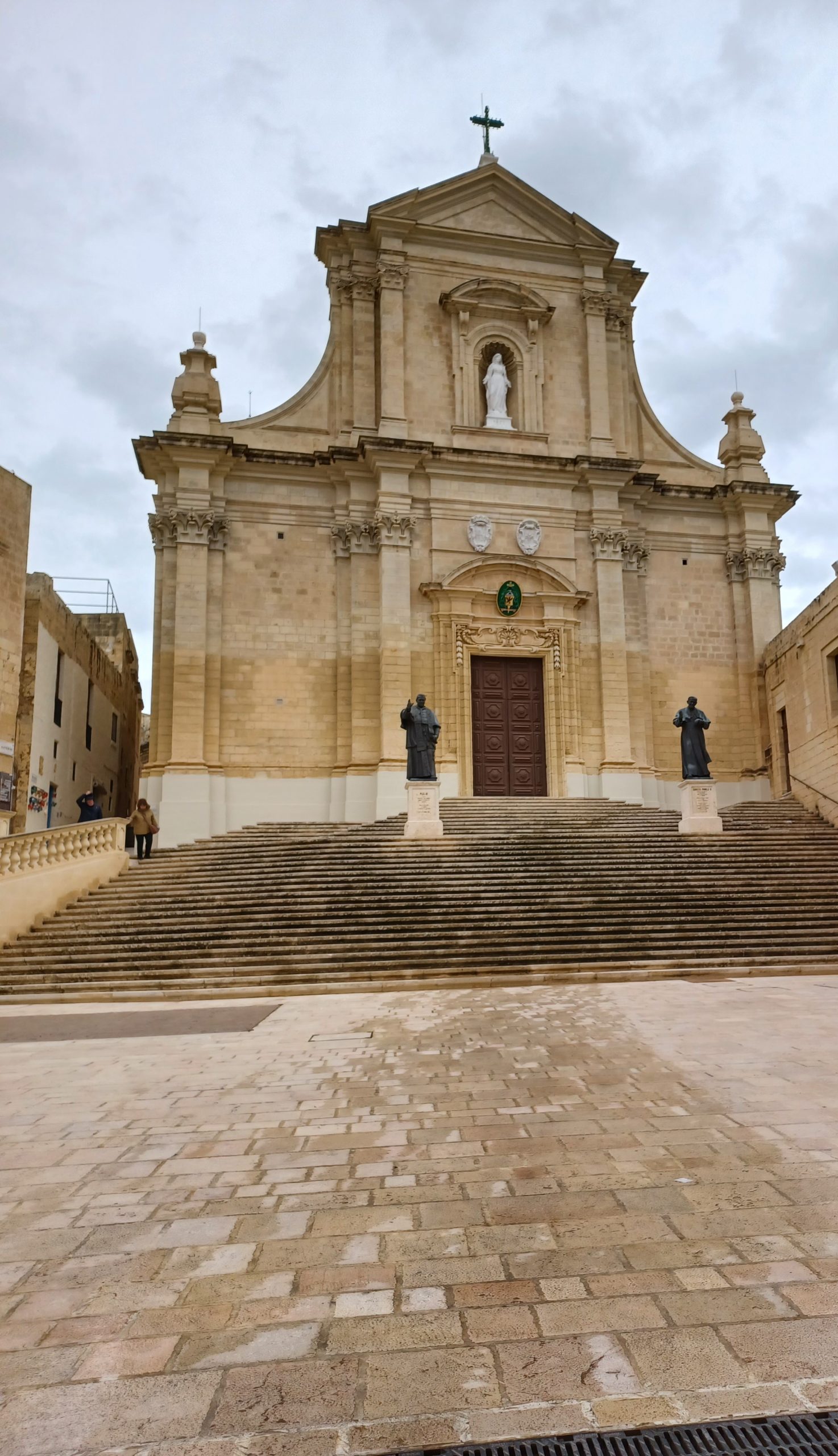
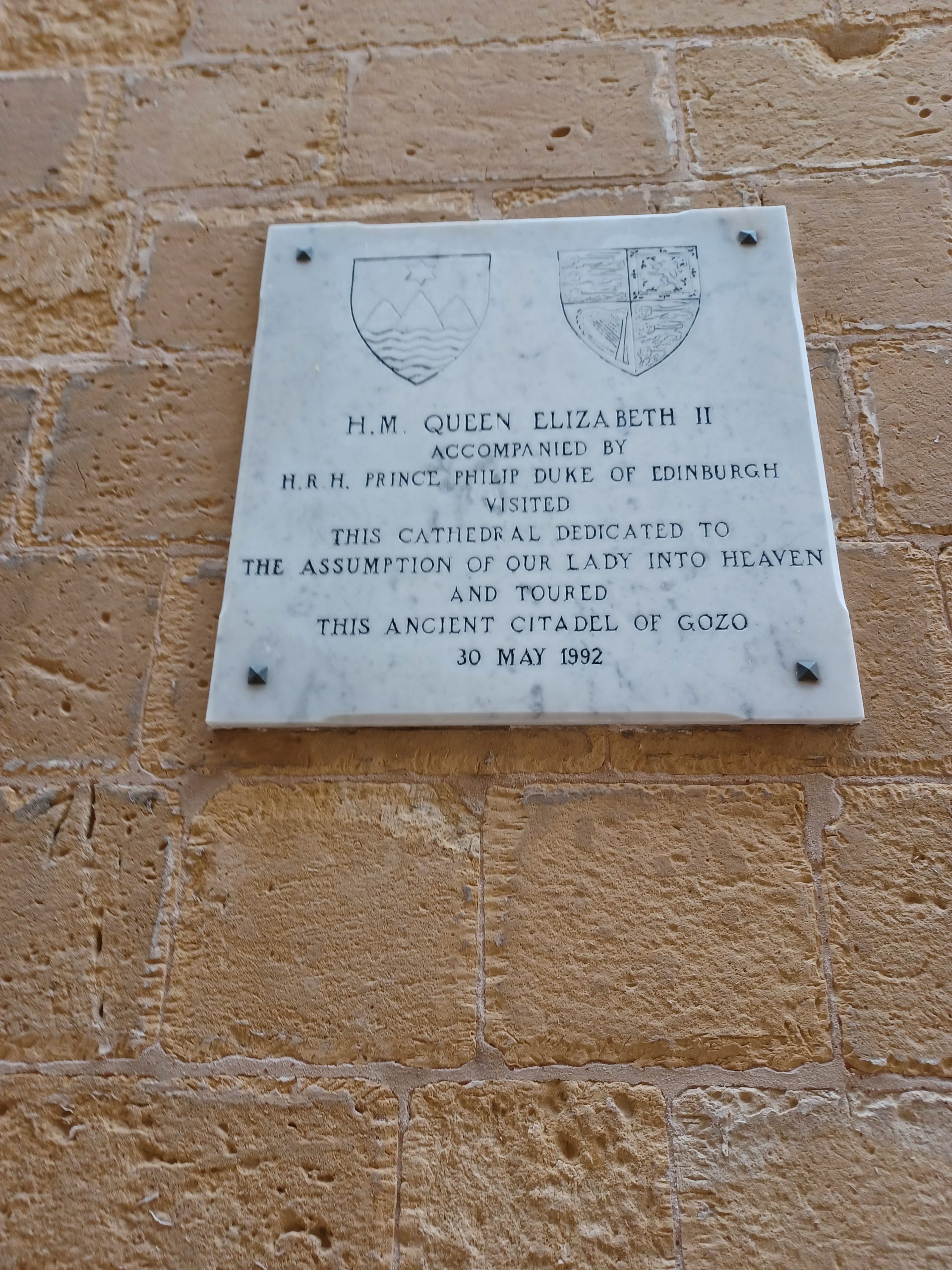
Descending into the town, we enter the first enticing looking café we can find to thaw out. A wonderful old place with white painted stone walls and arches and old framed photographs. We have some while to appreciate the décor as we slowly sip tea. Then, after a hasty peek inside St George’s basilica in the main square, we take to the car and the ferry back to Malta.
There was not time to see more of Malta in the short time we visited. Moreover, the weather was rather inclement in the second part of the week. Should we go again, October would doubtless be a better month than November. There was a lot we missed, even second time round. There are neolithic sites, such as the Tarxien temples, where one can see the bottom half of a massive stone female figure in a skirt; there is Marsaschlokk, where the stripy coloured boats in the harbour have an evil eye on their bows; bronze age forts, and many more sites to satisfy the curious.

Leave a Reply